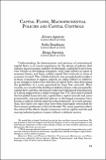Artículo
Capital flows macroprudential policies and capital controls
Date
2019Abstract
Understanding the determinants and patterns of international capital flows is of crucial importance for the design of policies that enhance macroeconomic stability. Traditionally capital flows have been very volatile in developing economies with large inflows in times of economic booms and large sudden capital flow reversals in times of economic turmoil. This volatile behavior has prompted policymakers in these economies to impose controls on either inflows or outflows in an attempt to reduce the volatility of capital flows thus decreasing the probability of a crisis generated by large flow reversals. More recently as a result of the buildup of global systemic risks prompted by capital flows and the subsequent rapid and widespread transmission of a shock originated in a single economy (the U.S.) that characterized the last global financial crisis capital flows capital controls and more prominently macroprudential policies in developed economies have become a subject of great interest in the profession1. It is only natural then that these are topics that have been thoroughly researched by the economic profession in the last decades. Yet many questions about the extent of the effects of policy measures such as capital controls and macroprudential policies remain without a definite answer.
Collections
View/


